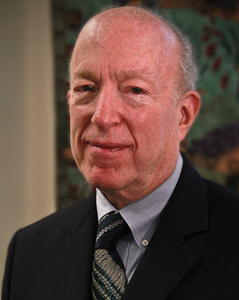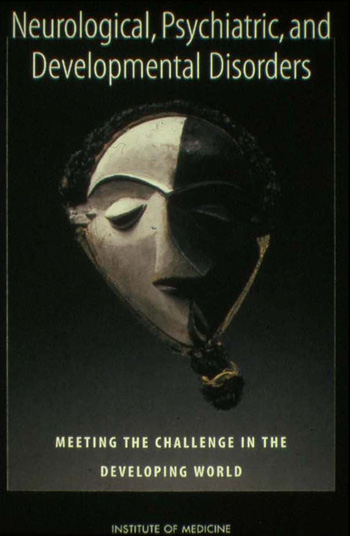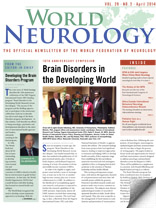
Donald H. Silberberg
The cover story of World Neurology describes the 10th anniversary celebration of the NIH/Fogarty International Center (FIC) funding program “Brain Disorders in the Developing World: Research Across the Lifespan.” The success of the program and the thrilling opportunity to participate in the anniversary celebration, leads me to describe my role in each stage of the Brain Disorders program development. In this column, I will describe my efforts to bring neurologic, psychiatric and developmental disorders to the attention of international health agencies and funders, ultimately resulting in the final program.
In 1988, The World Bank had about $4 billion in loans outstanding to developing countries (now termed low and middle income countries or LMICs) related to health, but no real structure to guide further investments. At that time, the World Health Organization (WHO) had a small division with little funding that focused on mental health and epilepsy.
The World Bank recognized the need to develop a more systematic approach to its funding. With the guidance of several foundations and the WHO, The World Bank commissioned Dean Jamison, Alan Lopez and Christopher Murray to review data and help develop background for what became the bank’s 1993 annual report, “Investing in Health.” This report was The World Bank’s first annual report to deal with health.
I was privileged to be one of the contributors to this effort, which set the stage for what followed. As an aside, the Global Burden of Disease (GBD) metric was developed and refined by Jameson, Lopez and Murray during their work on this project.
My participation in the work leading up to The World Bank’s annual report in turn led to the opportunity to be part of the Geneva-based Global Forum for Health Research (GFHR). The GFHR was organized by international health leaders from many institutions and countries to help develop an overall strategy for improving efforts to address health problems in LMICs. It is perhaps best known for coining “The 10/90 Gap,” which represents the fact that only 10 percent of global resources address the 90 percent of people who live in LMICs, and conversely that 90 percent of those resources target the 10 percent who live in wealthy countries.
 As part of their efforts, the GFHR offered competitive grants for the purpose of developing studies and reports dealing with specific problems. I applied for and received $150,000 as funding to develop a study of brain disorders in developing countries. I proposed to the Institute of Medicine (IOM) that they serve as the group to help develop the study. The IOM’s process is to assemble a team to discuss and then write the components of a study destined to become an IOM report. The process takes about one year to complete. I helped to establish the team of neurologists, psychiatrists, epidemiologists and social scientists who wrote the report that subsequently became the 2001 Institute of Medicine Report “Neurologic, Psychiatric and Developmental Disorders: Meeting the Challenge in the Developing World.”
As part of their efforts, the GFHR offered competitive grants for the purpose of developing studies and reports dealing with specific problems. I applied for and received $150,000 as funding to develop a study of brain disorders in developing countries. I proposed to the Institute of Medicine (IOM) that they serve as the group to help develop the study. The IOM’s process is to assemble a team to discuss and then write the components of a study destined to become an IOM report. The process takes about one year to complete. I helped to establish the team of neurologists, psychiatrists, epidemiologists and social scientists who wrote the report that subsequently became the 2001 Institute of Medicine Report “Neurologic, Psychiatric and Developmental Disorders: Meeting the Challenge in the Developing World.”
The title that we chose for the study and report reflected the team’s wish to represent all disorders affecting the nervous system throughout the lifespan.
One of our key recommendations was to establish a fund to promote research designed to ameliorate the major problems of those with nervous system disorders in LMICs. This recommendation, which at the time seemed much more like hope than reality, materialized in the form of the FIC/NIH Brain Disorders program. The way in which that happened was as follows: The grant from the GFHR was not adequate to cover the IOM’s costs of conducting the study and publishing the report. In the course of developing the additional funding that was needed, Gerald Keusch, then-director of NIH’s FIC, contributed and then saw the need and opportunity for Fogarty to develop the funding program, “Brain Disorders in the Developing World: Research Across The Lifespan,” that has been such a spectacular success. The FIC’s initiative required that relevant NIH Institutes, notably the National Institutes of Mental Health, Neurological Disorders and Stroke, Child Health and Development, contribute financially and programmatically. This, in turn, has served as a significant stimulus to these institutes to develop additional grant programs that focus on problems in LMICs.
It is likely that the IOM Report and/or the Brain Disorders Program also have served to stimulate the development of research and service programs by other agencies and governments around the world.
I hope that this description of my role in the development of the Brain Disorders program will help to illustrate the fact that one individual, reaching out to colleagues can make a difference in developing approaches to address neurologic, psychiatric and developmental problems, whether locally or globally.
